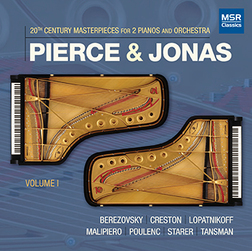Pierce & Jonas: 20th Century Masterpieces
View record and artist detailsRecord and Artist Details
Composer or Director: Nikolai Tikonovich Berezowsky, Alexandre Tansman, Francis Poulenc, Gian Francesco Malipiero, Nikolai Lopatnikov, Robert Starer, Paul Creston
Genre:
Orchestral
Label: MSR Classics
Magazine Review Date: 06/2018
Media Format: CD or Download
Media Runtime: 127
Mastering:
DDD
Catalogue Number: MS1651

Tracks:
| Composition | Artist Credit |
|---|---|
| Fantasie for Two Pianos and Orchestra |
Nikolai Tikonovich Berezowsky, Composer
David Amos, Conductor Nikolai Tikonovich Berezowsky, Composer Pierce & Jonas, Piano Polish Radio & TV Symphony Orchestra |
| Concerto for Two Pianos and Orchestra |
Paul Creston, Composer
David Amos, Conductor Paul Creston, Composer Pierce & Jonas, Piano Polish Radio & TV Symphony Orchestra |
| Concerto for 2 Pianos |
Nikolai Lopatnikov, Composer
David Amos, Conductor Nikolai Lopatnikov, Composer Pierce & Jonas, Piano Slovak State Philharmonic Orchestra, Kosice |
| Dialoghi VII |
Gian Francesco Malipiero, Composer
David Amos, Conductor Gian Francesco Malipiero, Composer Pierce & Jonas, Piano Slovak State Philharmonic Orchestra, Kosice |
| Concerto for Two Pianos |
Robert Starer, Composer
Carlos Piantini, Conductor Czech Radio Symphony Orchestra Pierce & Jonas, Piano Robert Starer, Composer |
| Suite |
Alexandre Tansman, Composer
Alexandre Tansman, Composer David Amos, Conductor Pierce & Jonas, Piano Slovak State Philharmonic Orchestra, Kosice |
Author: Jed Distler
Nikolai Lopatnikoff’s Concerto dates from 1949 50 and its sinewy concertante style suggests a more glittery manifestation of Hindemith. Tansman’s exuberant neoclassical style reaches inventive heights in a four-movement suite from 1928. The first movement’s combination of thick bitonal textures and chugging lopsided rhythms might be described as the lovechild of Stravinsky and Milhaud, although Tansman’s voice gorgeously steps up to the plate, so to speak, in the Lento’s intriguing interaction between the pianos and a solo clarinet. The third-movement Presto possible is a perpetual-motion study that begins with a murmur and ends in a whirlwind. Yet the inventively varied fourth-movement ‘Variations, Double Fugue and Finale’ proves anything but anticlimactic (I especially love the Sarabande variation’s sweeping expressive arcs and concentrated gravitas). Of the three short movements comprising Malipiero’s 1956 Dialoghi VII, I prefer the central Lento’s unpredictable plot line and harmonic originality to the outer movements’ Bartókian derivations, however exciting they may be on the surface. However, Nicolai Berezovsky’s two-movement Fantasie from 1931 abounds with personality, from the audacious glissandos and pounding pedal points at the outset to the Allegro vivo’s boundless brio and wit.
If Robert Starer makes his contrapuntal acumen a tad too obvious throughout his 1993 Concerto, his gift for deploying instruments, caustic first-desk soloist melodic rejoinders, non-generic percussion colorations and quirky hints of jazz constantly hold attention. However, Paul Creston’s 1951 Concerto seems more substantial in regard to its symphonic breadth, understated rhythmic variety and taut workmanship. The first movement features a good deal of demanding chordal interplay between pianists and orchestra, while tight motivic integration unifies the long Andante pastorale’s apparent rhapsodic trajectory. The vivid finale purports to be a tarantella, yet it is easier to grab an eel than to tap your foot alongside Creston’s cross-rhythmic phrase groupings.
Poulenc’s Two-Piano Concerto needs no introduction, except to say that the expertly dovetailed ensemble and pointedly precise fingerwork of Joshua Pierce and Dorothy Jonas (the finale’s rapid-fire repeated notes, for example) yield nothing to the catalogue competition. While loud passages reveal a monochrome patina to the pianos that may or may not be due to the otherwise clear and vivid engineering, there’s no doubt that the performances and interpretations were prepared with great care and expertise. Ditto the unusually informative and musically perceptive booklet notes by my late composer/writer colleague and friend Eric Salzman. Needless to say, I look forward to Vol 2.
Discover the world's largest classical music catalogue with Presto Music.

Gramophone Digital Club
- Digital Edition
- Digital Archive
- Reviews Database
- Full website access
From £8.75 / month
Subscribe
Gramophone Full Club
- Print Edition
- Digital Edition
- Digital Archive
- Reviews Database
- Full website access
From £11.00 / month
Subscribe
If you are a library, university or other organisation that would be interested in an institutional subscription to Gramophone please click here for further information.




